Brighton and Shoreham Tramways
History
The Brighton and Shoreham Tramways started life in 1884 as a steam-hauled operation, but quickly supplemented these services with horse trams. The steam services lasted for approximately 9 years, initially under the ownership of the Brighton and District Tramways Company (1884 to 1889), and subsequently under its successor, the Brighton and Shoreham Tramways Company (from 1889), before finally giving way to horse traction. The steam service probably saw only occasional use after 1889.
The entire share stock of the B&DTCo was acquired by the British Electric Traction Company in June 1898, the latter's intention being to expand and electrify the system; these plans, however, ultimately came to nought, so the system remained horse drawn to the end of its life on the 6th June 1913.
Uniforms
Photographic evidence from the steam-hauled years (1884 to c1893) is extremely limited, so it is not possible to state with any certainty what the staff who worked these services wore, though the single surviving photograph (shown below) does suggest that in common with the majority of UK steam-operated tramways, drivers probably wore very similar attire to their railway counterparts, such as heavy cotton trousers and jackets, along with cotton or flat caps. It is unlikely that either the jackets or the caps bore any badges. Evidence for steam-tram conductors is also limited, though if it is assumed that at least one of the eight individuals depicted on the one surviving photograph must be the conductor, then it seems likely that they wore informal attire.
Photographs of the first decade or so of horse operation appear not to have survived at all, the earliest known being from around the time of the British Electric Traction Company takeover (1897). The latter, over the course of its history, either owned, part-owned or leased almost 50 tramway concerns across the British Isles, and its clear intention was to electrify the line, after which it would no doubt have imposed a standard uniform policy, as it did elsewhere. The electrification plans were, however, never realised, in large part due to the intransigence of Hove, so the BETCo was left to operate an antiquated horse-drawn system, directly from 1907 onwards, through to its demise in 1913.
It would appear that the BETCo was content to allow staff to continue wearing smart, probably self-purchased attire, though evidence is once again sparse. Staff were, however, certainly issued with uniforms during the early Edwardian era, as a staff photograph survives from 1905. These uniforms took the form of single-breasted jackets with five buttons, a left-breast pocket (with flap closure) and high fold-over collars; the latter do not appear to have carried any insignia. The peaked caps had an unusually wide, soft-topped crown (top); they probably carried an employee number, though there remains a possibility that this may in fact have been the standard BETCo 'Magnet and Wheel' cap badge. The uniforms were markedly different to those worn on other BETCo-owned systems, perhaps reflecting the fact that electrification had failed to materialise.
From 1907 onwards, the photographic record is particularly strong, and shows that the company had abandoned issuing uniforms altogether, being content for staff to wear informal but smart attire. No insignia of any kind appears to have been worn, including licence badges.
It is unclear what uniforms, if any, were worn by inspectors prior to the BETCo take-over. Two photographs have, however, survived ofBETCo inspectors. The first, taken in 1905, shows an inspector wearing a typical BETCo senior staff uniform, comprising a single-breasted jacket with hidden buttons (or more likely a hook and eye affair), four slit pockets, with the pockets and jackets edged in a finer material than the main body, and with stand-up collars; the latter carried the designation 'Inspector' in embroidered script lettering. The tensioned-crown peaked cap appears to have borne the standard BETCo 'Magnet & Wheel' cap badge, with the grade — 'Inspector' — embroidered in script lettering on a hat band below. This stands in contrast to the 'last day' photograph, which appears to show an inspector wearing a double-breasted jacket (with plain buttons), three hip/waist-level pockets and lapels, along with a tensioned-crown peaked cap. Neither the jacket nor the cap appear to bear insignia.
Further reading
For further reading on the Brighton and Shoreham Tramways, see: 'A History of the British Steam Tram, Volume 2' by David Gladwin; Adam Gordon Publishing (2008).
Images
Steam drivers and conductors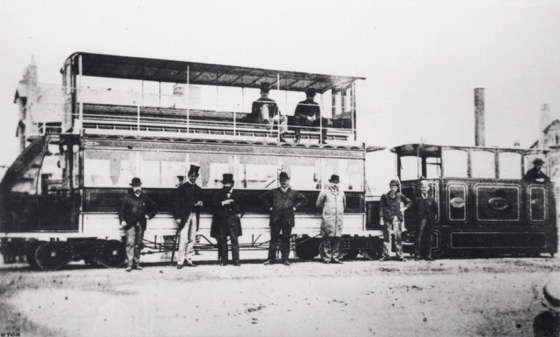
A rather poor-quality photograph, but the only one known to have survived depicting a Brighton and District Tramways Company steam tram (Wilkinson No 2) in the ownership of that company. The photo was taken at Westbourne Villas on the opening day, 3rd July 1884. No-one present is wearing a uniform. Photo courtesy of the Tramways and Light Railway Society, with thanks to David Voice.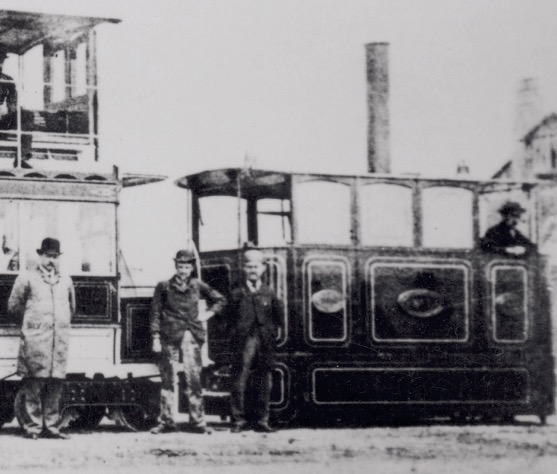
An enlargement of the above photograph showing the driver (in the cab) with a stoker or fitter in the middle.
Horse tram drivers and conductors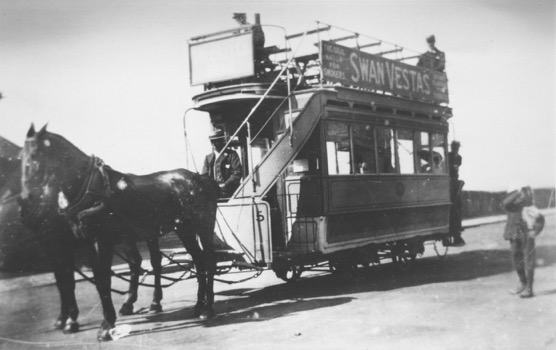
Horsecar No 5 captured on a summer's day in 1897 between Southwick and Fishersgate. Photo courtesy of the Tramways and Light Railway Society, with thanks to David Voice.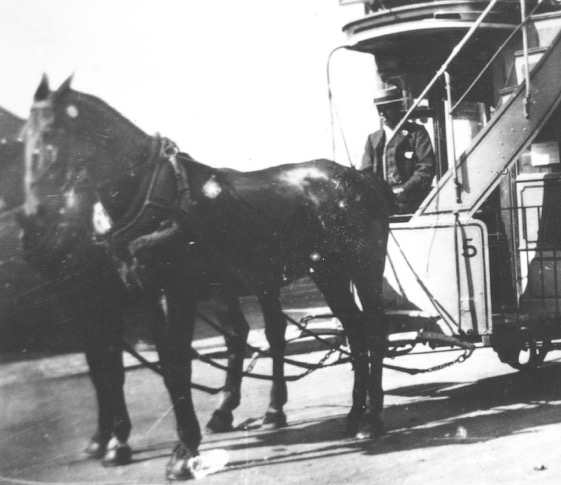
An enlargement of the above photograph showing the driver, who is wearing informal but smart attire, along with a straw boater. 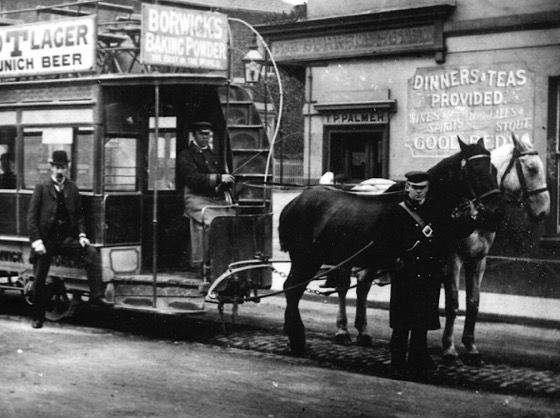
The crew of Horsecar No 11 pose for the camera at the Shoreham terminus — photo purportedly taken circa 1904. Both the driver and conductor (holding the horses) are wearing soft-topped caps, seemingly without insignia, along with what are probably self-purchased coats. Photo courtesy of the Tramways and Light Railway Society, with thanks to David Voice.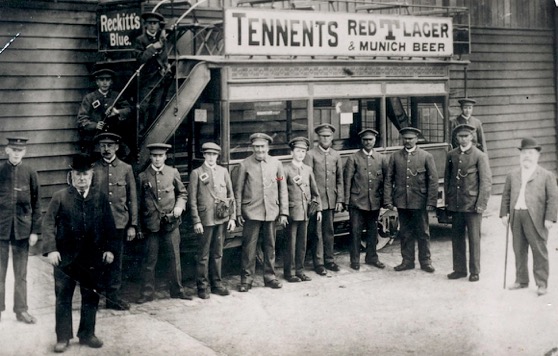
A staff photograph purportedly taken in 1905. All the tramcar staff are wearing uniforms, a policy which appears to have lapsed by 1907. Photo courtesy of the Tramways and Light Railway Society, with thanks to David Voice.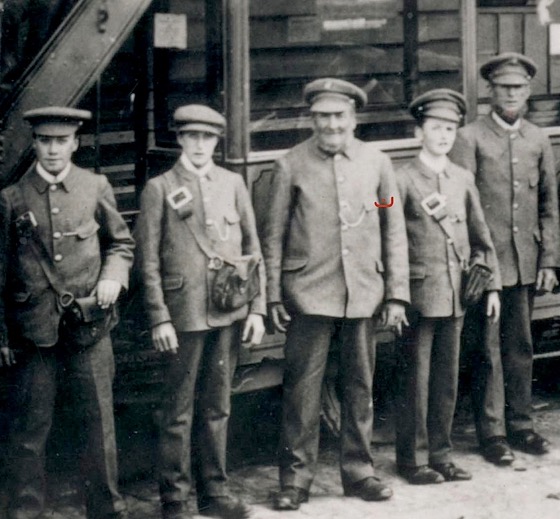
An enlargement of the above photograph showing a group of very young conductors and drivers (with the exception of the individual in the centre). The cap badge is probably an employee number, though there remains a possibility that it is the standard BETCo 'Magnet & Wheel' issue. The caps have an unusually wide, soft-topped crown, giving an almost convex appearance. These uniforms are like no others used on BETCo tramway systems of the period, so were very probably locally sourced.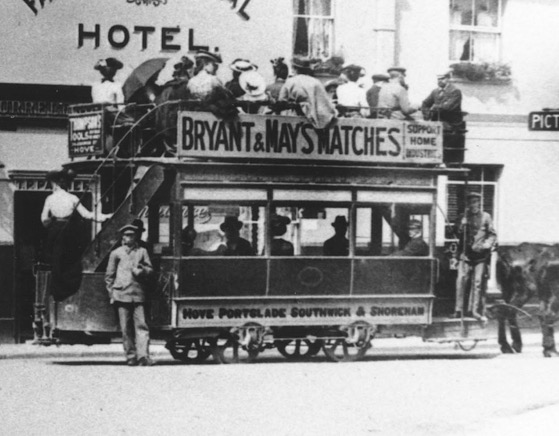
B&STCo Horsecar No 12 stands outside the Burrell Hotel in 1905. Both the driver and conductor are wearing the uniforms seen in the 1905 staff photograph above. Photo courtesy of the Tramways and Light Railway Society, with thanks to David Voice.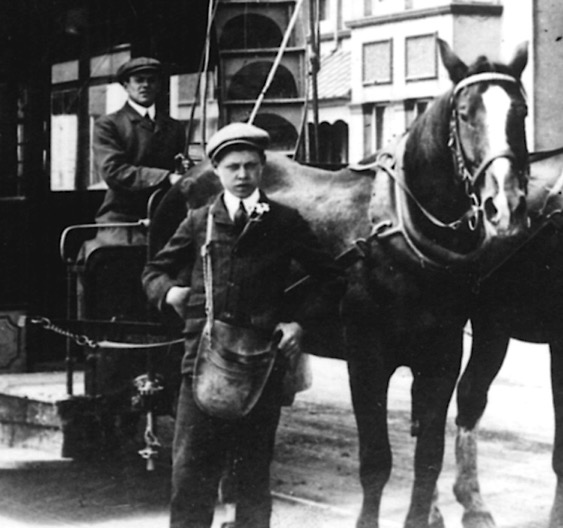
The rather indignant looking conductor of Horsecar No 12 scrutinises the cameraman at the passing loop opposite Kingston Terrace in 1907. Neither the conductor nor the driver are wearing uniforms or insignia of any description. Photo courtesy of the Tramways and Light Railway Society, with thanks to David Voice.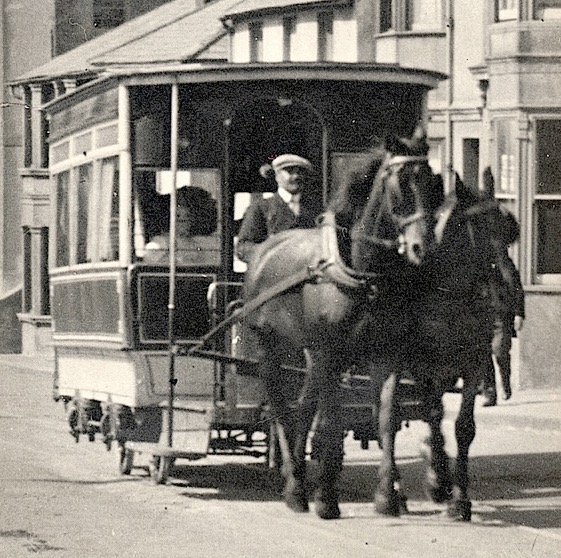
Driver Ben Fears with Tramcar No 10 at Southwick in 1910. Photo courtesy of the Tramways and Light Railway Society, with thanks to David Voice.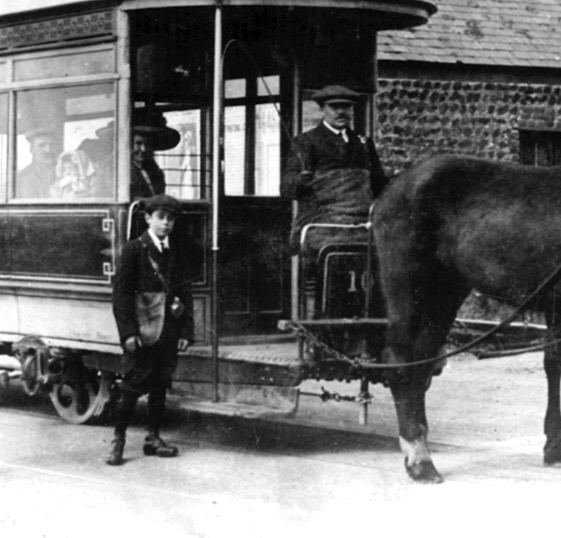
A very youthful conductor and his driver (Ben Fears), with the last operational tramcar (No 10) at the Fishersgate Terrace loop — photo undated, but probably taken around 1912. Photo courtesy of the Tramways and Light Railway Society, with particular thanks to David Voice.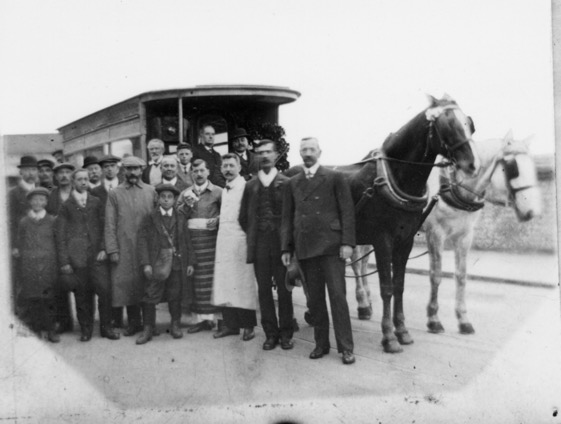
A photograph which is unfortunately out of focus, but which is believed to have been taken on the last day of operation (Friday, 6th June 1913). Note that this photograph has been previously and erroneously ascribed to the the London, Deptford and Southwark Tramways. My thanks go to Nicholas Kelly for the correct identification and background information.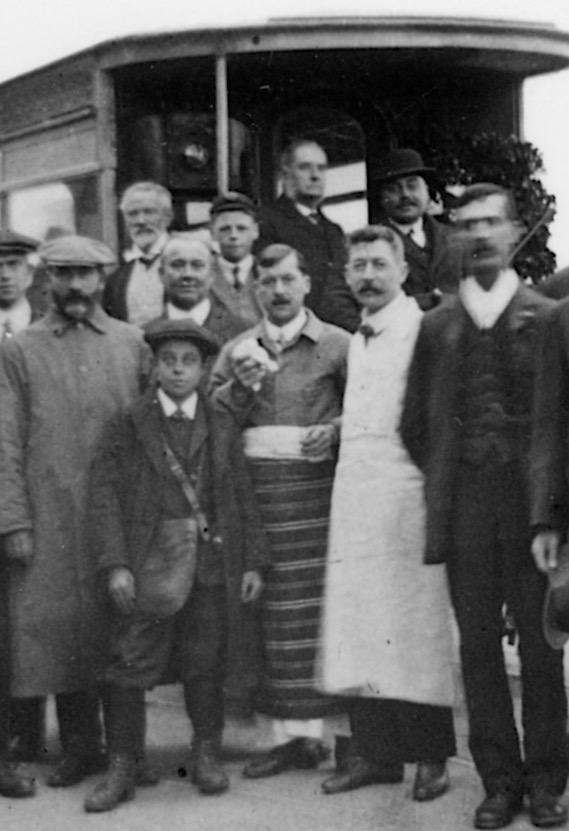
An enlargement of the above photograph showing Conductor Albert James (2nd from left with cash bag) and Driver Ben Fears (back right wearing a bowler hat). Albert James was the subject of a Daily Mirror article published on the 13th May 1913, in which he claimed to be the youngest tram conductor (at 14 years of age) in the country. Once again, my thanks go to Nicholas Kelly for this information.
Senior staff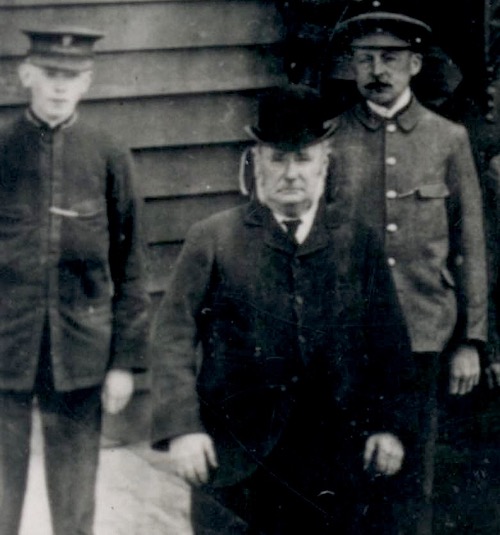
An enlargement of the 1905 staff photograph above showing, on the extreme left, a rather youthful-looking inspector. He appears to be wearing a standard BETCo 'Magnet & Wheel' cap badge, above an embroidered Inspector badge.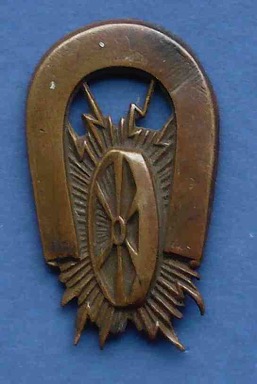
Standard British Electric Traction Company cap badge — brass. This was possibly worn by the B&STCo's single inspector. Author's Collection.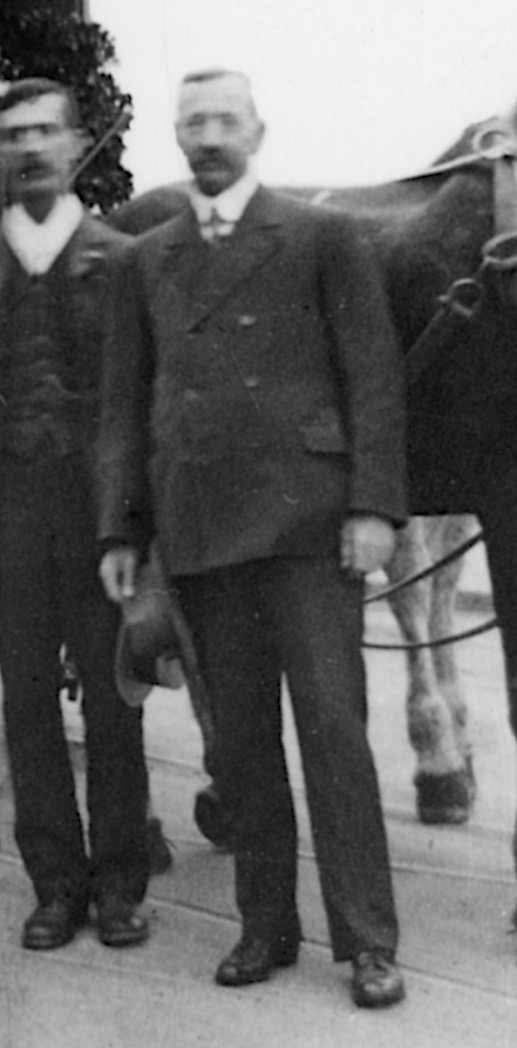
An enlargement of the 'last day' photograph above showing the only man in uniform, who is in all probability an inspector. He is holding a tensioned-crown peaked cap. The jacket, at least, does not appear to bear any insignia.